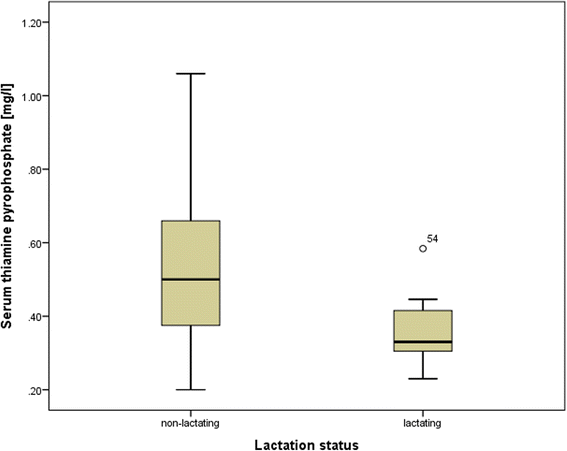Vitamin blood concentration and vitamin supplementation in bottlenose dolphins (Tursiops truncatus) in European facilities
- PMID: 27596136
- PMCID: PMC5011994
- DOI: 10.1186/s12917-016-0818-1
Vitamin blood concentration and vitamin supplementation in bottlenose dolphins (Tursiops truncatus) in European facilities
Abstract
Background: As fish eaters bottlenose dolphins (Tursiops truncatus) in human care need to receive daily vitamin supplementation, because whole thawed fish lacks certain vitamins. However, the exact concentration of supplementation has not been established and is a matter of discussion. To ensure adequate vitamin supplementation in pets, vitamin blood concentrations are measured. This is not a common practice in dolphins. The objective of the present study was to collect information about vitamin supplementation in bottlenose dolphins and on vitamin blood concentrations of healthy animals in European facilities. In addition, these results were compared with blood levels of wild animals. Conclusions on how to provide bottlenose dolphins in human care with an effective vitamin supplementation will then be drawn. Initially, fish-handling techniques and vitamin supplementation were evaluated by questionnaire, which was sent to 25 European facilities that house bottlenose dolphins. Secondly, blood samples from 57 dolphins living in 10 facilities were taken and sent by mail to a reference laboratory. They were analysed for retinol, thiamine pyrophosphate, cobalamin, calcidiol and tocopherol. The blood concentrations were then correlated with vitamin supplementation, fish handling techniques and pre-existing blood concentrations of free-ranging dolphins. Finally, the data was subjected to a standard analysis of variance techniques (ANOVA) and a linear model analysis.
Results: Fish was mainly thawed in a refrigerator. Further, the 95 % confidence interval for retinol blood concentrations was 0.048 to 0.059 mg/l and for tocopherol 17.95 to 20.76 mg/l. These concentrations were 27 and 53 %, respectively, higher than those found in free-ranging animals. In contrast, calcidiol concentrations (143.9-174.7 ng/ml) of the dolphins in human care were lower than in blood found for free-ranging animals. Regarding thiamine pyrophosphate and cobalamin, concentrations ranged between 0.42 and 0.55 mg/l and 175.55 and 275.22 pg/ml respectively. No reference concentrations for free-ranging Tursiops truncatus were found.
Conclusions: These findings suggest an over-supplementation of retinol (vitamin A) and tocopherol (vitamin E) in bottlenose dolphins (Tursiops truncatus) housed in human care. Therefore, vitamin A supplementation should not exceed 50,000 IU per animal per day and vitamin E supplementation should be around 100 IU per kg fed fish per day.
Keywords: Bottlenose dolphin; Calcidiol; Cobalamin; Fish thawing; Retinol; Thiamine; Tocopherol; Tursiops truncatus; Vitamin blood concentration; Vitamin supplementation.
Figures



Similar articles
-
Assessment of mercury and selenium concentrations in captive bottlenose dolphin's (Tursiops truncatus) diet fish, blood, and tissue.Sci Total Environ. 2012 Jan 1;414:220-6. doi: 10.1016/j.scitotenv.2011.11.021. Epub 2011 Dec 3. Sci Total Environ. 2012. PMID: 22137650
-
Dietary cation-anion difference may explain why ammonium urate nephrolithiasis occurs more frequently in common bottlenose dolphins () under human care than in free-ranging common bottlenose dolphins.J Anim Sci. 2017 Mar;95(3):1396-1406. doi: 10.2527/jas.2016.1113. J Anim Sci. 2017. PMID: 28380506
-
THE NUTRIENT COMPOSITION OF THE DIET OF BOTTLENOSE DOLPHINS (TURSIOPS TRUNCATUS) IS BETTER ASSESSED RELATIVE TO METABOLIZABLE ENERGY THAN DRY MATTER.J Zoo Wildl Med. 2015 Jun;46(2):198-204. doi: 10.1638/2014-0064R1.1. J Zoo Wildl Med. 2015. PMID: 26056869
-
The Gulf of Ambracia's Common Bottlenose Dolphins, Tursiops truncatus: A Highly Dense and yet Threatened Population.Adv Mar Biol. 2016;75:259-296. doi: 10.1016/bs.amb.2016.07.002. Epub 2016 Aug 25. Adv Mar Biol. 2016. PMID: 27770987 Review.
-
Health and Environmental Risk Assessment Project for bottlenose dolphins Tursiops truncatus from the southeastern USA. II. Environmental aspects.Dis Aquat Organ. 2017 Jul 24;125(2):155-166. doi: 10.3354/dao03143. Dis Aquat Organ. 2017. PMID: 28737160 Review.
Cited by
-
Microarchitecture of cetacean vertebral trabecular bone among swimming modes and diving behaviors.J Anat. 2021 Mar;238(3):643-652. doi: 10.1111/joa.13329. Epub 2020 Oct 14. J Anat. 2021. PMID: 33058161 Free PMC article.
-
Subclinical thiamine deficiency results in failed reproduction in Arctic foxes.Vet Med Sci. 2024 Mar;10(2):e1358. doi: 10.1002/vms3.1358. Vet Med Sci. 2024. PMID: 38356320 Free PMC article.
-
Effects of Storage Time and Thawing Method on Selected Nutrients in Whole Fish for Zoo Animal Nutrition.Animals (Basel). 2022 Oct 19;12(20):2847. doi: 10.3390/ani12202847. Animals (Basel). 2022. PMID: 36290233 Free PMC article.
References
-
- Manteca X, Villalba JJ, Atwood SB, Dziba L, Provenza FD. Is dietary choice important to animal welfare? J Vet Behav. 2008;3(5):229–39. doi: 10.1016/j.jveb.2008.05.005. - DOI
-
- Crissey SD. Handling fish fed to fish-eating animals: A manual of standard operating procedures. Beltsville: United States Department of Agriculture (USDA), Agriculture Research Service, National Agricultural Library, Animal and Plant Health Inspection Service (APHIS); 1998.
-
- Worthy GA. Nutrition and energetics. In: Dierauf LA, Gulland MD, editors. CRC handbook of marine mammal medicine, 2nd edn. Boca Raton: CRC Press; 2001. p. 791–817.
-
- Barros NB, Wells RS. Prey and feeding patterns of resident bottlenose dolphins (Tursiops truncatus) in Sarasota Bay, Florida. J Mammal. 1998;79:1045–59. doi: 10.2307/1383114. - DOI
-
- Pauly D, Trites AW, Capuli E, Christensen V. Diet composition and trophic levels of marine mammals. ICES J Mar Sci. 1998;55:467–81. doi: 10.1006/jmsc.1997.0280. - DOI
MeSH terms
Substances
LinkOut - more resources
Full Text Sources
Other Literature Sources
Medical
Research Materials

